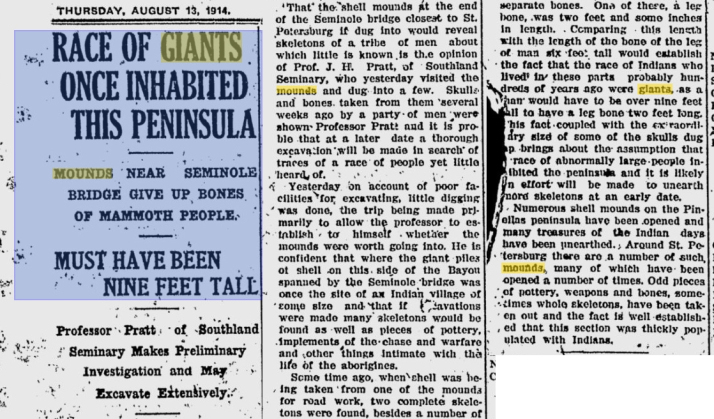Seminole Bridge’s 9 foot skeletons
RACE OF GIANTS ONCE INHABITED THIS PENINSULA
MOUNDS NEAR SEMINOLE BRIDGE GIVE UP BONES OF MAMMOTH PEOPLE.
MUST HAVE BEEN NINE FEET TALL
Professor Pratt of Southland Seminary Makes Preliminary Investigation and May Excavate Extensively.
That the shell mounds at the end of the Seminole bridge closest to St. Petersburg, if dug into, would reveal skeletons of a tribe of men about which little is known, is the opinion of Prof. J. H. Pratt of Southland Seminary, who yesterday visited the mounds and dug into a few skulls and bones taken from them several weeks ago by a party of men were shown to Professor Pratt, and it is probable that at a later date a thorough excavation will be made in search of traces of a race of people yet little heard of.
Yesterday, on account of poor facilities for excavating, little digging was done. The trip was primarily made to allow the professor to establish for himself whether the mounds were worth exploring. He is confident that where the giant piles of shell on this side of the Bayou, spanned by the Seminole bridge, was once the site of an Indian village of some size, and that if excavations were made, many skeletons would be found as well as pieces of pottery, implements of the chase and warfare, and other things intimate with the life of the aborigines.
Some time ago, when shell was being taken from one of the mounds for road work, two complete skeletons were found, besides a number of separate bones. One of these, a leg bone, was two feet and some inches in length. Comparing this length with the length of the bone of the leg of a man six feet tall would establish the fact that the race of Indians who lived in these parts probably hundreds of years ago were giants, as a man would have to be over nine feet tall to have a leg bone two feet long. This fact, coupled with the extraordinary size of some of the skulls dug up, brings about the assumption that a race of abnormally large people inhabited the peninsula, and it is likely that an effort will be made to unearth more skeletons at an early date.
Numerous shell mounds on the Pinellas peninsula have been opened, and many treasures of the Indian days have been unearthed. Around St. Petersburg, there are a number of such mounds, many of which have been opened a number of times. Odd pieces of pottery, weapons, and bones, sometimes whole skeletons, have been taken out, and the fact is well-established that this section was thickly populated with Indians.
- St Petersburg, Thursday, August 13, 1914.
- Research done by Rephaim23
- http://rephaim23.wordpress.com/2012/09/22/giant-research-pt-1/
- Journal Gazette, August 13, 1914

Comment